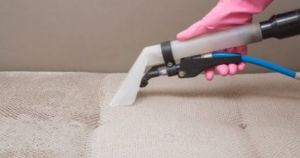Whether you’re dealing with a nasty stain or hoping to give your furniture a regular cleaning, you’ll need to clean it differently depending on the fabric it is made out of. It can get confusing, which is why we’ve made a guide to go over the best upholstery cleaning solutions for each fabric that your furniture is made out of. To keep things simple, we will be using a futon in our examples since they tend to get dirty easily, along with the fact that they don’t have removable parts for easier cleaning.
How To Start for All Fabrics
Regardless of the materials your futon is made out of, you’ll need to check the label attached to the bottom to see what the manufacturer recommends avoiding when attempting to clean it. On the tag, you will see one of the following symbols, which all have various meanings:
- X: Only clean with a vacuum or have it done by a professional
- W: Only use water-based cleaners
- S: Only use solvent-based cleaners
- WS: Use either water- or solvent-based cleaners
No matter what the fabric or tag recommendations say, you should always start cleaning with a vacuum. This will remove any loose dirt, crumbs, or hair that would get in your way while performing a deeper clean. If you’re trying to clean a specific spot, the vacuum will also suck up any moisture that hasn’t had time to set in. Also, if you’re using a cloth to clean, make sure it’s white, so the dyes don’t bleed into your couch while cleaning.
Natural Fabrics
Cotton and other natural fabrics are the easiest to clean. Almost every cleaning solution on the market is safe to use on them. Just make sure you check the back of the bottle before purchasing a cleaning solution. Once the cleaner is on the futon and doing its job, you’ll have to scrub it a bit to help it out. Don’t rub too hard, though, or else you’ll push the dirt deeper inside. Instead, lightly dab at it.
Synthetic Fabrics
Materials such as polyester are a little more complicated but still manageable. Keep your cleaning solution simple. Dish soap and basic shampoos work best for these. Performing a gentle cleaning is even more critical here because letting stains or cleaning solutions seep into the cushions can damage the look and feel of your futon. Also, be sure to dry it thoroughly to avoid the forming of mold and mildew.
Leather-Based Fabrics
Cleaning leather is straightforward, but you must be careful not to overdo it. If you prepare a bowl with equal parts water and vinegar, you’re pretty much set. Then, simply dampen a washcloth and wipe your futon down. Just be sure not to get the leather too wet, or you might cause permanent damage.
Easy Prevention Method
After learning about the best upholstery cleaning solutions for each fabric, if you don’t want to have to worry about cleaning futon stains like this ever again, then we’d recommend checking out our futon slipcovers. You can easily remove and throw them into the washer for easy cleaning, and you won’t have to worry about stains soaking in or the cleaning solution harming your futon.

